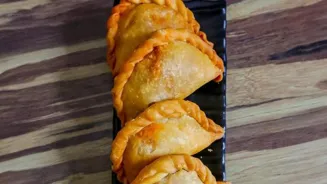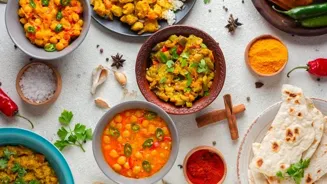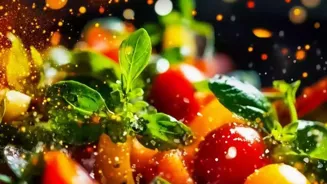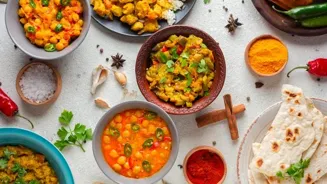Unveiling the Samosa's Epic Journey: From Ancient Origins to India's Delightful Snack. Discover its flavorful evolution!
The samosa! Ah, the very name conjures up images of steaming hot, crispy triangles
filled with spicy potatoes and peas. It's a snack synonymous with India, found everywhere from fancy restaurants to humble street carts.
But did you know that this beloved snack has a fascinating history, travelling across continents and cultures before becoming the iconic Indian treat we know and love? Buckle up, because we're about to embark on a journey through time to uncover the amazing story of the samosa.
Samosa's rich Middle Eastern origins and evolution eastward
Our samosa saga begins not in India, but in the Middle East. Historians believe the samosa's ancestor, a pastry called "sambusak" or "samsa," originated in the region sometime before the 10th century.
These early sambusaks were larger than the bite-sized treats we enjoy today and contained fillings of minced meat (lamb or beef!), nuts like almonds and pistachios and even dried fruits. Imagine these flavors!
Picture the bustling marketplaces of Persia or the grand courts of the Middle Eastern empires, where these savory pastries were enjoyed as a common snack or a part of grand feasts.
These early renditions of the samosa were a culinary luxury, showcasing the region's rich ingredients and culinary expertise. This provides crucial background for understanding the samosa's evolution as it traveled eastward.
Traders carried samosas along Silk Road, shaping Indian cuisine
The samosa's journey eastward began with traders traveling along the Silk Road. Think of those long camel caravans crossing deserts, carrying goods and ideas across vast distances.
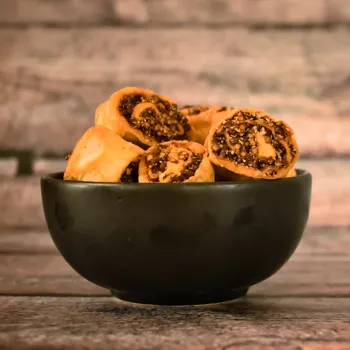
As these merchants traversed the trade routes connecting the Middle East to Central Asia and eventually India, they brought with them their culture, cuisine, and yes, the sambusak. The pastry adapted and evolved along the way, picking up regional flavors and ingredients.
In Central Asia, the samosa continued to be popular, maintaining its meaty filling and often being baked instead of fried.
It was from Central Asia that the samosa finally made its way into the Indian subcontinent, carried along with the influx of traders, travelers, and armies during the Delhi Sultanate period. This movement of people and cultures had a profound impact on India's culinary landscape.
Indian samosa: from meaty to veggie, a culinary transformation
Upon arriving in India, the samosa underwent yet another transformation. Perhaps influenced by dietary restrictions or simply the availability of local ingredients, the meaty fillings were replaced with vegetarian options.
Potatoes, peas, and lentils, readily available and staple ingredients in the Indian diet, became the new stars of the samosa. Spices, of course, played a crucial role. The addition of cumin, coriander, ginger, and chili pepper gave the samosa its signature Indian flavor.
This transformation was not just about ingredients; it reflected a significant shift in culinary identity. The Indian samosa became a unique creation, distinct from its Middle Eastern and Central Asian ancestors.
The vegetarian filling catered to a wider audience, aligning with the predominantly vegetarian dietary practices in certain regions of India.
Samosa's versatility showcases India's culinary diversity
The samosa quickly integrated itself into the diverse culinary landscape of India. Different regions developed their own variations, using locally available ingredients and spices. In Punjab, you'll find the classic potato and pea filling, often served with a tangy tamarind chutney.
In Gujarat, a sweeter version called "patti samosa" is popular, with a lighter, flakier pastry. Even in the south, you can find samosas with unique fillings that reflect local tastes. The beauty of the samosa lies in its adaptability.
Its simple form allows for endless possibilities in terms of filling and flavor, making it a canvas for culinary creativity. This regional variation is a testament to India's rich cultural diversity and how culinary traditions are constantly evolving and adapting.
The samosa: a beloved Indian snack symbolizing culture and unity
From the royal kitchens of the Mughal emperors to the street food stalls of bustling cities, the samosa has become an integral part of Indian life. Whether enjoyed as a quick snack, a tea-time treat, or a party appetizer, the samosa brings people together.
It evokes feelings of nostalgia, comfort, and joy. It is more than just a food item; it is a cultural icon. It's a reminder of India's rich history and its ability to absorb and adapt influences from around the world.
The samosa embodies the spirit of India: diverse, flavorful, and utterly irresistible. Its enduring popularity is a testament to its deliciousness and its ability to connect people across generations and cultures.
Samosa: a cultural journey from Middle East to India
So, the next time you bite into a hot, crispy samosa, take a moment to appreciate its incredible journey through time.
From its humble beginnings in the Middle East to its current status as India's beloved snack, the samosa's story is a delicious reminder of the interconnectedness of cultures and the enduring power of food.
It has crisscrossed continents, adapting and evolving with each new encounter, now you know the tale behind India’s favorite tea time snack.
